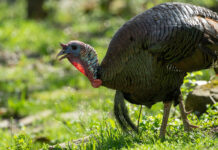As summer winds down, we expect cooler, drier air to make life a little more comfortable. But nature is far from predictable. Why hike a favorite trail or canoe a favorite lake if the results are always the same?
Environmental cues
When I’m outdoors, I hope to see things I’ve never seen before. There is, however, one environmental constant that influences what we observe — changing day length.
The shorter days of August and September are an absolutely reliable environmental cue. In late summer, nothing foretells the approach of autumn as well as ever shorter days. Deciduous trees respond by donning fall colors. The drone of cicadas by day and katydids at night begin to fade. And birds migrate.
Migration
From distinctive V-shaped flocks of migrating geese to kettles of broad-winged hawks sailing south along mountain ridges, migrating birds flee the coming winter by heading south. Many songbirds escape detection by migrating at night.
On a cold clear fall night, scan the moon with binoculars. You just might catch silhouettes of migrating birds crossing the path of the moon. It’s an impressive, memorable, and moving sight. And keep your ears tuned to the night sky.
Many songbirds vocalize as they migrate, presumably to keep in touch with other members of the southbound flock. Ornithologists suggest that nocturnal flight calls help migrating individuals organize their spacing and avoid collisions.
Researchers at the Cornell Lab of Ornithology report on a good migration night in eastern North America, thousands of calls can be heard by listeners on the ground. Migrating at night permits celestial navigation, night skies offer more stable atmospheric conditions, and fewer predators patrol the night sky.
Reasons to travel
Birds migrate for several reasons — to escape winter weather, to find a dependable food supply and, in spring, to find a place to nest.
Blackpoll warblers, for example, fly from Maine to South America across the open Atlantic Ocean. Bristle-thighed curlews nest on Alaska’s west coast and winter in Polynesia, a distance of about 6,000 miles.
After nesting off the southern coast of Australia, short-tailed shearwaters circle the Pacific Ocean before returning the following year. They travel north along the Asian coast, head east across the Bering Sea, then south along the coasts of Alaska and British Columbia before striking out across the Pacific and back to Australia. The journey covers 20,000 miles.
Arctic terns that nest in Greenland travel south along the coasts of Great Britain, Spain and west Africa, then wing their way west and south across the Atlantic Ocean to Antarctica for the austral summer.
When the Antarctic weather deteriorates, they complete the circuit by heading north along the coasts of South and North America to their arctic breeding grounds. The total length of this incredible journey measures about 22,000 miles.
Endless summer
And then there are sooty shearwaters. Steve Shaffer and his team tracked 19 shearwaters from two breeding colonies in New Zealand for 222 to 313 days in 2005. The average migration path of 32,422 miles was the longest ever recorded.
Sooty shearwaters are small seabirds that weigh less than two pounds. They roam the Pacific Ocean from Antarctica to the Bering Sea and from Japan to Chile. Shaffer’s team found the annual migration of tagged birds makes a large figure-eight that spans the Pacific and lasts an average of 198 days.
By flying such vast distances, sooty shearwaters exploit an “endless summer” away from their nesting area in the south Pacific. The timing of their movements places the birds in the most productive areas of the ocean at any given time of year. Where ever they are, food (fish, squid, and krill) is abundant.
The movements of sooty shearwaters make them a truly global species. Shaffer suggests because sooty shearwater activities span the entire Pacific Ocean, they may help biologists understand the ecological impacts of global climate change, an oceanic variation on the canary in the coal mine.
Shaffer also suggests that the sooty shearwater’s figure-eight migratory path is possible thanks to global wind patterns and the Coriolis effect. The rotation of the earth, combined with near-constant oceanic winds, make flying long distances easier than it might seem.













